英文隐喻修辞格及汉语翻译
- 格式:pdf
- 大小:156.83 KB
- 文档页数:2
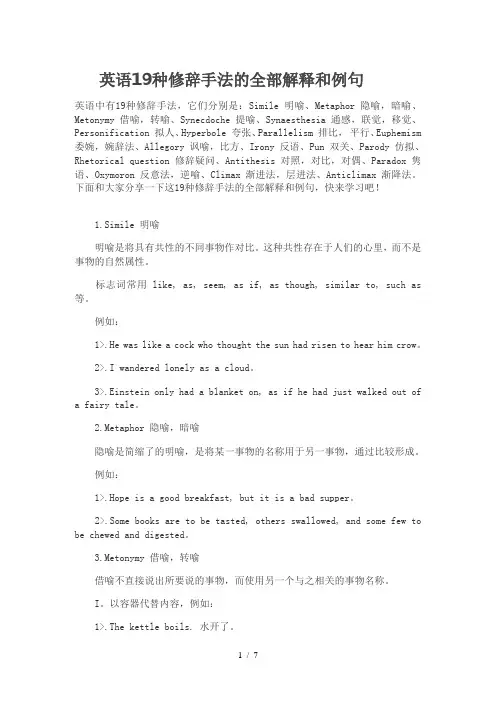
英语19种修辞手法的全部解释和例句英语中有19种修辞手法,它们分别是:Simile明喻、Metaphor 隐喻,暗喻、Metonymy 借喻,转喻、Synecdoche 提喻、Synaesthesia 通感,联觉,移觉、Personification 拟人、Hyperbole 夸张、Parallelism 排比,平行、Euphemism 委婉,婉辞法、Allegory 讽喻,比方、Irony 反语、Pun 双关、Parody 仿拟、Rhetorical question 修辞疑问、Antithesis 对照,对比,对偶、Paradox 隽语、Oxymoron 反意法,逆喻、Climax 渐进法,层进法、Anticlimax 渐降法。
下面和大家分享一下这19种修辞手法的全部解释和例句,快来学习吧!1.Simile 明喻明喻是将具有共性的不同事物作对比。
这种共性存在于人们的心里,而不是事物的自然属性。
标志词常用 like, as, seem, as if, as though, similar to, such as 等。
例如:1>.He was like a cock who thought the sun had risen to hear him crow。
2>.I wandered lonely as a cloud。
3>.Einstein only had a blanket on, as if he had just walked out ofa fairy tale。
2.Metaphor 隐喻,暗喻隐喻是简缩了的明喻,是将某一事物的名称用于另一事物,通过比较形成。
例如:1>.Hope is a good breakfast, but it is a bad supper。
2>.Some books are to be tasted, others swallowed, and some few to be chewed and digested。
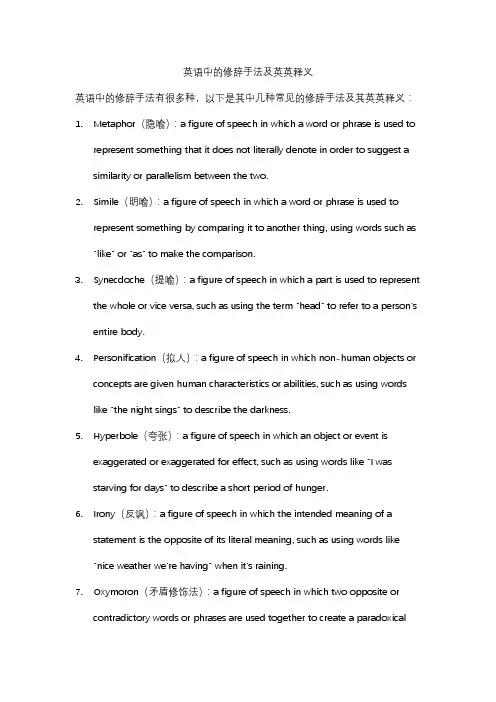
英语中的修辞手法及英英释义英语中的修辞手法有很多种,以下是其中几种常见的修辞手法及其英英释义:1.Metaphor(隐喻):a figure of speech in which a word or phrase is used torepresent something that it does not literally denote in order to suggest a similarity or parallelism between the two.2.Simile(明喻):a figure of speech in which a word or phrase is used torepresent something by comparing it to another thing, using words such as "like" or "as" to make the comparison.3.Synecdoche(提喻):a figure of speech in which a part is used to representthe whole or vice versa, such as using the term "head" to refer to a person's entire body.4.Personification(拟人):a figure of speech in which non-human objects orconcepts are given human characteristics or abilities, such as using words like "the night sings" to describe the darkness.5.Hyperbole(夸张):a figure of speech in which an object or event isexaggerated or exaggerated for effect, such as using words like "I wasstarving for days" to describe a short period of hunger.6.Irony(反讽):a figure of speech in which the intended meaning of astatement is the opposite of its literal meaning, such as using words like"nice weather we're having" when it's raining.7.Oxymoron(矛盾修饰法):a figure of speech in which two opposite orcontradictory words or phrases are used together to create a paradoxicaleffect, such as using words like "bittersweet" to describe a mixed feeling of happiness and sadness.这些修辞手法都可以增强语言的表达力,帮助传达更深刻的意义。
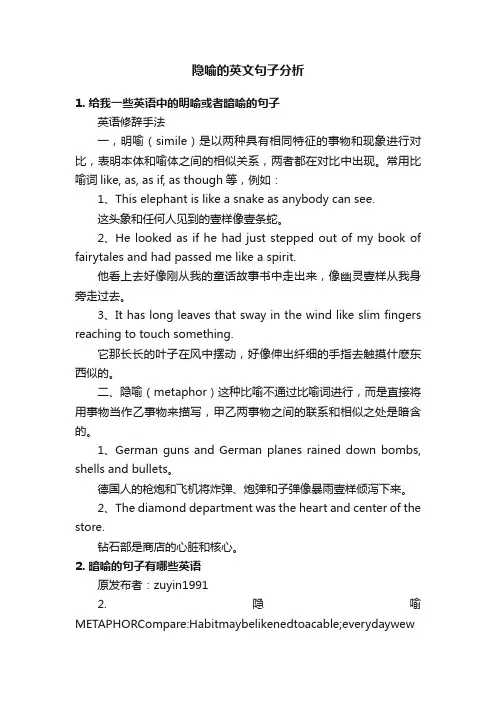
隐喻的英文句子分析1. 给我一些英语中的明喻或者暗喻的句子英语修辞手法一,明喻(simile)是以两种具有相同特征的事物和现象进行对比,表明本体和喻体之间的相似关系,两者都在对比中出现。
常用比喻词like, as, as if, as though等,例如:1、This elephant is like a snake as anybody can see.这头象和任何人见到的壹样像壹条蛇。
2、He looked as if he had just stepped out of my book of fairytales and had passed me like a spirit.他看上去好像刚从我的童话故事书中走出来,像幽灵壹样从我身旁走过去。
3、It has long leaves that sway in the wind like slim fingers reaching to touch something.它那长长的叶子在风中摆动,好像伸出纤细的手指去触摸什麽东西似的。
二、隐喻(metaphor)这种比喻不通过比喻词进行,而是直接将用事物当作乙事物来描写,甲乙两事物之间的联系和相似之处是暗含的。
1、German guns and German planes rained down bombs, shells and bullets。
德国人的枪炮和飞机将炸弹、炮弹和子弹像暴雨壹样倾泻下来。
2、The diamond department was the heart and center of the store.钻石部是商店的心脏和核心。
2. 暗喻的句子有哪些英语原发布者:zuyin19912.隐喻METAPHORCompare:Habitmaybelikenedtoacable;everydayweweaveathread,andsoonwecannotbreakit.习惯像缆索,每天我们编上一条线,习惯像缆索,每天我们编上一条线,不久我们便扯不断了。
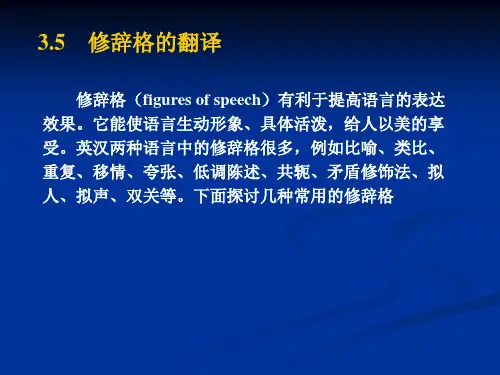
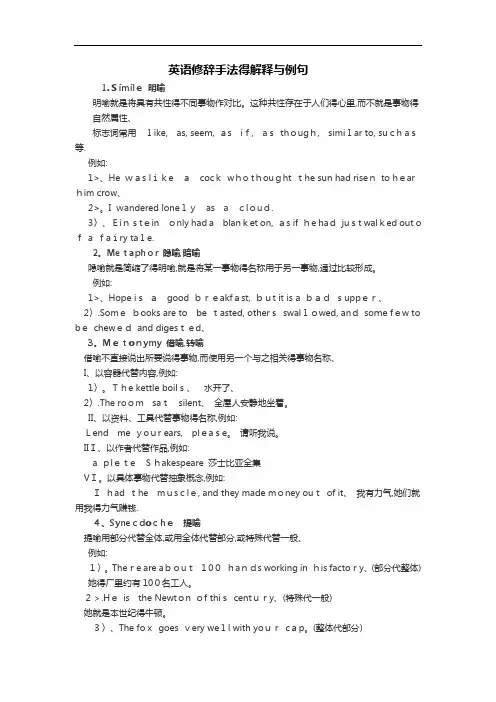
英语修辞手法得解释与例句1.Simile明喻明喻就是将具有共性得不同事物作对比。
这种共性存在于人们得心里,而不就是事物得自然属性、标志词常用like, as, seem, as if, asthough, similar to, such as等.例如:1>、He was like acockwho thought the sun had risento hear him crow、2>。
I wandered lonelyas a cloud.3〉、Einstein only had a blanket on, as if he hadjust walked out o fa fairy tale.2。
Metaphor 隐喻,暗喻隐喻就是简缩了得明喻,就是将某一事物得名称用于另一事物,通过比较形成。
例如:1>、Hope isagood breakfast, but it is a badsupper、2〉.Somebooks are to be tasted, othersswallowed, andsome few to bechewedand digested、3。
Metonymy 借喻,转喻借喻不直接说出所要说得事物,而使用另一个与之相关得事物名称、I、以容器代替内容,例如:1〉。
The kettle boils、水开了、2〉.The room satsilent、全屋人安静地坐着。
II、以资料、工具代替事物得名称,例如:Lend me your ears, please。
请听我说。
III、以作者代替作品,例如:a plete Shakespeare 莎士比亚全集VI。
以具体事物代替抽象概念,例如:Ihad the muscle, and they made money outof it、我有力气,她们就用我得力气赚钱.4、Synecdoche提喻提喻用部分代替全体,或用全体代替部分,或特殊代替一般、例如:1〉。
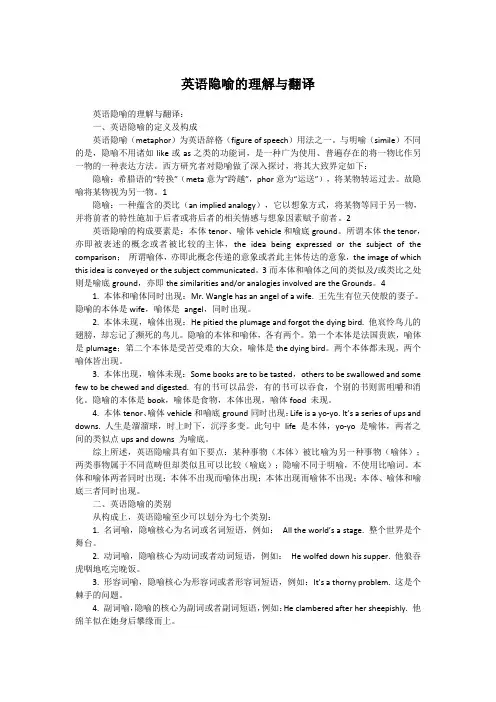
英语隐喻的理解与翻译英语隐喻的理解与翻译:一、英语隐喻的定义及构成英语隐喻(metaphor)为英语辞格(figure of speech)用法之一。
与明喻(simile)不同的是,隐喻不用诸如like或as之类的功能词,是一种广为使用、普遍存在的将一物比作另一物的一种表达方法。
西方研究者对隐喻做了深入探讨,将其大致界定如下:隐喻:希腊语的“转换”(meta意为“跨越”,phor意为“运送”),将某物转运过去。
故隐喻将某物视为另一物。
1隐喻:一种蕴含的类比(an implied analogy),它以想象方式,将某物等同于另一物,并将前者的特性施加于后者或将后者的相关情感与想象因素赋予前者。
2英语隐喻的构成要素是:本体tenor、喻体vehicle和喻底ground。
所谓本体the tenor,亦即被表述的概念或者被比较的主体,the idea being expressed or the subject of the comparison;所谓喻体,亦即此概念传递的意象或者此主体传达的意象,the image of which this idea is conveyed or the subject communicated。
3而本体和喻体之间的类似及/或类比之处则是喻底ground,亦即the similarities and/or analogies involved are the Grounds。
41. 本体和喻体同时出现:Mr. Wangle has an angel of a wife. 王先生有位天使般的妻子。
隐喻的本体是wife,喻体是angel,同时出现。
2. 本体未现,喻体出现:He pitied the plumage and forgot the dying bird. 他哀怜鸟儿的翅膀,却忘记了濒死的鸟儿。
隐喻的本体和喻体,各有两个。
第一个本体是法国贵族,喻体是plumage;第二个本体是受苦受难的大众,喻体是the dying bird。
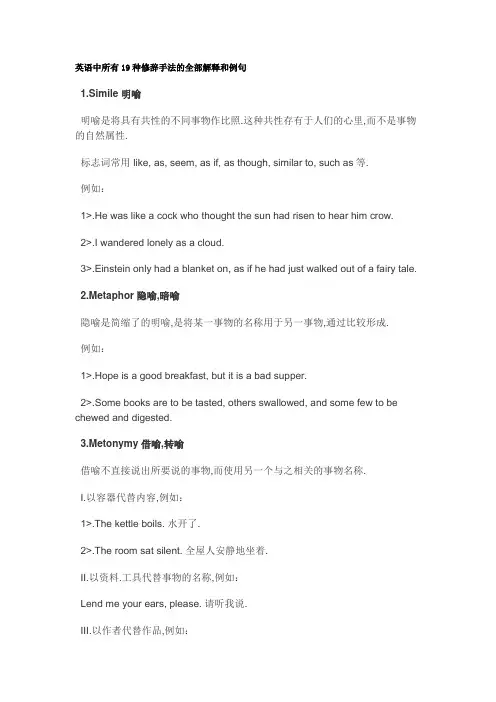
英语中所有19种修辞手法的全部解释和例句1.Simile 明喻明喻是将具有共性的不同事物作比照.这种共性存有于人们的心里,而不是事物的自然属性.标志词常用 like, as, seem, as if, as though, similar to, such as等.例如:1>.He was like a cock who thought the sun had risen to hear him crow.2>.I wandered lonely as a cloud.3>.Einstein only had a blanket on, as if he had just walked out of a fairy tale.2.Metaphor 隐喻,暗喻隐喻是简缩了的明喻,是将某一事物的名称用于另一事物,通过比较形成.例如:1>.Hope is a good breakfast, but it is a bad supper.2>.Some books are to be tasted, others swallowed, and some few to be chewed and digested.3.Metonymy 借喻,转喻借喻不直接说出所要说的事物,而使用另一个与之相关的事物名称.I.以容器代替内容,例如:1>.The kettle boils. 水开了.2>.The room sat silent. 全屋人安静地坐着.II.以资料.工具代替事物的名称,例如:Lend me your ears, please. 请听我说.III.以作者代替作品,例如:a complete Shakespeare 莎士比亚全集VI.以具体事物代替抽象概念,例如:I had the muscle, and they made money out of it. 我有力气,他们就用我的力气赚钱.4.Synecdoche 提喻提喻用局部代替全体,或用全体代替局部,或特殊代替一般.例如:1>.There are about 100 hands working in his factory.(局部代整体)他的厂里约有100名工人.2>.He is the Newton of this century.(特殊代一般)他是本世纪的牛顿.3>.The fox goes very well with your cap.(整体代局部)这狐皮围脖与你的帽子很相配.5.Synaesthesia 通感,联觉,移觉这种修辞法是以视.听.触.嗅.味等感觉直接描写事物.通感就是把不同感官的感觉沟通起来,借联想引起感觉转移,“以感觉写感觉”。
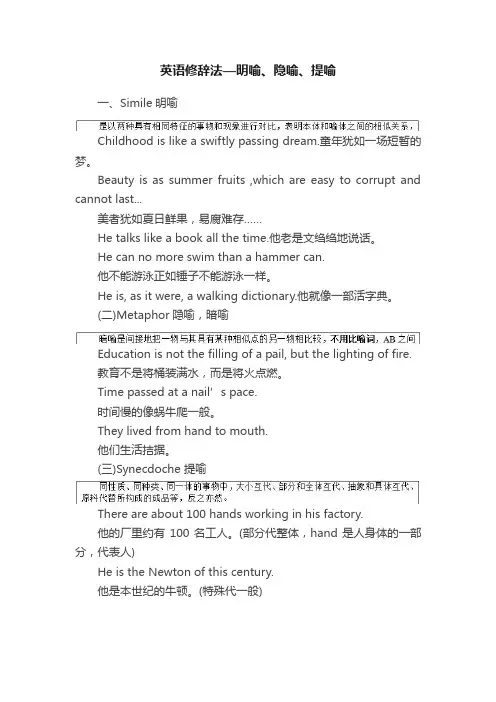
英语修辞法—明喻、隐喻、提喻
一、Simile明喻
Childhood is like a swiftly passing dream.童年犹如一场短暂的梦。
Beauty is as summer fruits ,which are easy to corrupt and cannot last...
美者犹如夏日鲜果,易腐难存……
He talks like a book all the time.他老是文绉绉地说话。
He can no more swim than a hammer can.
他不能游泳正如锤子不能游泳一样。
He is, as it were, a walking dictionary.他就像一部活字典。
(二)Metaphor隐喻,暗喻
Education is not the filling of a pail, but the lighting of fire.
教育不是将桶装满水,而是将火点燃。
Time passed at a nail’s pace.
时间慢的像蜗牛爬一般。
They lived from hand to mouth.
他们生活拮据。
(三)Synecdoche 提喻
There are about 100 hands working in his factory.
他的厂里约有100名工人。
(部分代整体,hand是人身体的一部分,代表人)
He is the Newton of this century.
他是本世纪的牛顿。
(特殊代一般)。
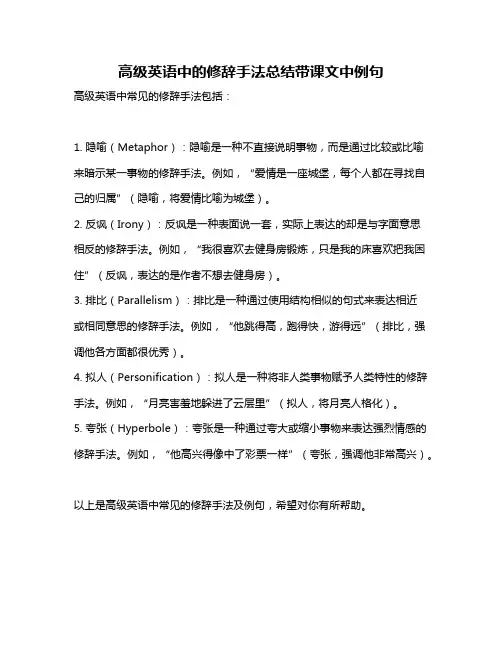
高级英语中的修辞手法总结带课文中例句
高级英语中常见的修辞手法包括:
1. 隐喻(Metaphor):隐喻是一种不直接说明事物,而是通过比较或比喻来暗示某一事物的修辞手法。
例如,“爱情是一座城堡,每个人都在寻找自己的归属”(隐喻,将爱情比喻为城堡)。
2. 反讽(Irony):反讽是一种表面说一套,实际上表达的却是与字面意思
相反的修辞手法。
例如,“我很喜欢去健身房锻炼,只是我的床喜欢把我困住”(反讽,表达的是作者不想去健身房)。
3. 排比(Parallelism):排比是一种通过使用结构相似的句式来表达相近
或相同意思的修辞手法。
例如,“他跳得高,跑得快,游得远”(排比,强调他各方面都很优秀)。
4. 拟人(Personification):拟人是一种将非人类事物赋予人类特性的修辞手法。
例如,“月亮害羞地躲进了云层里”(拟人,将月亮人格化)。
5. 夸张(Hyperbole):夸张是一种通过夸大或缩小事物来表达强烈情感的修辞手法。
例如,“他高兴得像中了彩票一样”(夸张,强调他非常高兴)。
以上是高级英语中常见的修辞手法及例句,希望对你有所帮助。
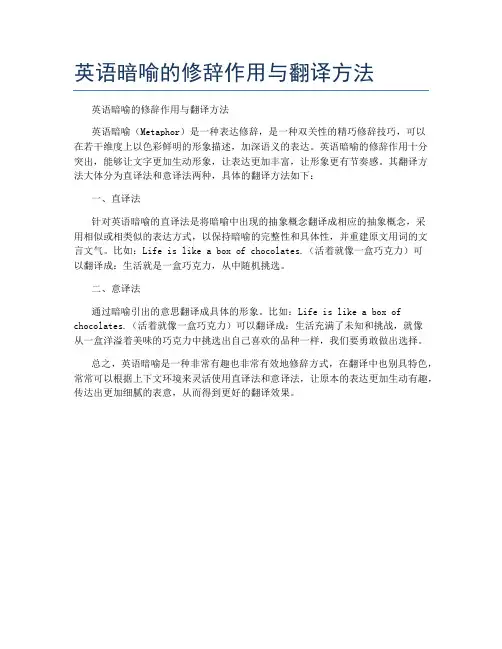
英语暗喻的修辞作用与翻译方法英语暗喻的修辞作用与翻译方法
英语暗喻(Metaphor)是一种表达修辞,是一种双关性的精巧修辞技巧,可以
在若干维度上以色彩鲜明的形象描述,加深语义的表达。
英语暗喻的修辞作用十分突出,能够让文字更加生动形象,让表达更加丰富,让形象更有节奏感。
其翻译方法大体分为直译法和意译法两种,具体的翻译方法如下:
一、直译法
针对英语暗喻的直译法是将暗喻中出现的抽象概念翻译成相应的抽象概念,采
用相似或相类似的表达方式,以保持暗喻的完整性和具体性,并重建原文用词的文言文气。
比如:Life is like a box of chocolates.(活着就像一盒巧克力)可
以翻译成:生活就是一盒巧克力,从中随机挑选。
二、意译法
通过暗喻引出的意思翻译成具体的形象。
比如:Life is like a box of chocolates.(活着就像一盒巧克力)可以翻译成:生活充满了未知和挑战,就像
从一盒洋溢着美味的巧克力中挑选出自己喜欢的品种一样,我们要勇敢做出选择。
总之,英语暗喻是一种非常有趣也非常有效地修辞方式,在翻译中也别具特色,常常可以根据上下文环境来灵活使用直译法和意译法,让原本的表达更加生动有趣,传达出更加细腻的表意,从而得到更好的翻译效果。
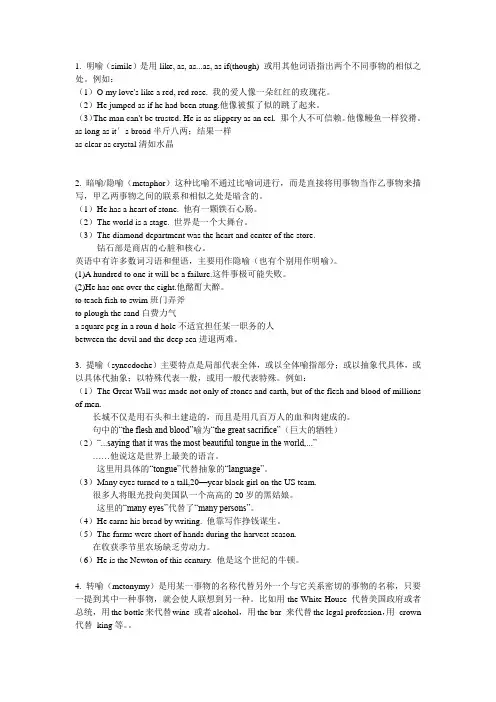
1. 明喻(simile)是用like, as, as...as, as if(though) 或用其他词语指出两个不同事物的相似之处。
例如:(1)O my love's like a red, red rose. 我的爱人像一朵红红的玫瑰花。
(2)He jumped as if he had been stung.他像被蜇了似的跳了起来。
(3)The man can't be trusted. He is as slippery as an eel. 那个人不可信赖。
他像鳗鱼一样狡猾。
as long as it′s broad半斤八两;结果一样as clear as crystal清如水晶2. 暗喻/隐喻(metaphor)这种比喻不通过比喻词进行,而是直接将用事物当作乙事物来描写,甲乙两事物之间的联系和相似之处是暗含的。
(1)He has a heart of stone. 他有一颗铁石心肠。
(2)The world is a stage. 世界是一个大舞台。
(3)The diamond department was the heart and center of the store.钻石部是商店的心脏和核心。
英语中有许多数词习语和俚语,主要用作隐喻(也有个别用作明喻)。
(1)A hundred to one it will be a failure.这件事极可能失败。
(2)He has one over the eight.他酩酊大醉。
to teach fish to swim班门弄斧to plough the sand白费力气a square peg in a roun d hole不适宜担任某一职务的人between the devil and the deep sea进退两难。
3. 提喻(synecdoche)主要特点是局部代表全体,或以全体喻指部分;或以抽象代具体,或以具体代抽象;以特殊代表一般,或用一般代表特殊。
英语修辞手法一、明喻(simile):是以两种具有相同特征的事物和现象进行对比,表明本体和喻体之间的相似关系,两者都在对比中出现。
常用比喻词like, as, as if, as though等,例如:This elephant is like a snake as anybody can see.这头象和任何人见到的一样像一条蛇。
二、隐喻(metaphor):这种比喻不通过比喻词进行,而是直接将用事物当作乙事物来描写,甲乙两事物之间的联系和相似之处是暗含的。
German guns and German planes rained down bombs, shells and bullets...德国人的枪炮和飞机将炸弹、炮弹和子弹像暴雨一样倾泻下来。
三、提喻(synecdoche):又称举隅法,主要特点是局部代表全体,或以全体喻指部分,或以抽象代具体,或以具体代抽象。
例如:The Great Wall was made not only of stones and earth, but of the flesh and blood of millions of men.长城不仅是用石头和土建造的,而且是用几百万人的血和肉建成的句中的“the flesh and blood”喻为“the great sacrifice”(巨大的牺牲)四、拟人(personification):这种修辞方法是把人类的特点、特性加于外界事物之上,使之人格化,以物拟人,以达到彼此交融,合二为一。
She may have tens of thousand of babies in one summer.(From“ Watching Ants”) 一个夏天她可能生育成千上万个孩子。
这里用“she”和“babies”把蜜蜂比作人类妇女的生育。
五、夸张(hyperbole):这是运用丰富的想象,过激的言词,渲染和装饰客观事物,以达到强调的效果。
英语中所有19种修辞手法的全部解释和例句拟声onomatopoeia,头韵alliteration,半韵assonance,移就transferred epithet,圆周句periodic sentences,反复repetition,倒装inversion,延喻 extended metaphor,共轭zeugma,嘲讽 ridicule 典故allusion1.Simile 明喻明喻是将具有共性的不同事物作对比.这种共性存在于人们的心里,而不是事物的自然属性.标志词常用 like, as, seem, as if, as though, similar to, such as等.例如:1>.He was like a cock who thought the sun had risen to hear him crow.2>.I wandered lonely as a cloud.3>.Einstein only had a blanket on, as if he had just walked out of a fairy tale.2.Metaphor 隐喻,暗喻隐喻是简缩了的明喻,是将某一事物的名称用于另一事物,通过比较形成.例如:1>.Hope is a good breakfast, but it is a bad supper.2>.Some books are to be tasted, others swallowed, and some few to be chewed and digested.3.Metonymy 借喻,转喻[mɪ'tɒnɪmɪ]借喻不直接说出所要说的事物,而使用另一个与之相关的事物名称.I.以容器代替内容,例如:1>.The kettle boils. 水开了.2>.The room sat silent. 全屋人安静地坐着.II.以资料.工具代替事物的名称,例如:Lend me your ears, please. 请听我说.III.以作者代替作品,例如:a complete Shakespeare 莎士比亚全集VI.以具体事物代替抽象概念,例如:I had the muscle, and they made money out of it. 我有力气,他们就用我的力气赚钱.4.Synecdoche 提喻[sɪ'nekdəkɪ]提喻用部分代替全体,或用全体代替部分,或特殊代替一般.例如:1>.There are about 100 hands working in his factory.(部分代整体)他的厂里约有100名工人.2>.He is the Newton of this century.(特殊代一般)他是本世纪的牛顿.3>.The fox goes very well with your cap.(整体代部分)这狐皮围脖与你的帽子很相配.5.Synaesthesia 通感,联觉,移觉[,sɪnɪs'θiːzɪə]这种修辞法是以视.听.触.嗅.味等感觉直接描写事物.通感就是把不同感官的感觉沟通起来,借联想引起感觉转移,“以感觉写感觉”。
Figures of Speech1.Simile 明喻A simile is a very common figure of speech that uses the words “like” and “as” to compare two things that are not related by definition. For example, “he is as tall as a mountain,” does not mean he was actually 1,000 feet tall, it just means he was really tall.The Internet is like a window to the world—you can learn about everything online!2.Metaphor 暗喻A metaphor makes a comparison between two unlike things or ideas.Hope is a good breakfast, but it is a bad supper.Time is money.The world is a stage.She's a night owl.3.Alliteration 押头韵Alliteration is the repetition of the beginning sounds of neighboring words.She sells seashells.Walter wondered where Winnie was.Nick needed new notebooks.4.Euphemism 委婉Euphemism is a mild, indirect, or vague term that often substitutes a harsh, blunt, or offensive term.Letting you go instead of firing youPassed away instead of 'died.'Economical with the truth instead of liarHe is out visiting the necessary.5.Hyperbole 夸张Hyperbole uses exaggeration for emphasis or effect.I've told you to stop a thousand times.That must have cost a billion dollars.She's older than dirt.When she heard the bad news, a river of tears poured out.6.Oxymoron 矛盾修饰,逆喻An oxymoron is when you use two words together that have contradictory meanings. Some common examples include old news, little giant.For instance, imagine a woman who has a thirty-five year old son who still lives in her attic, playing video games and refusing to get a real job. An oxymoronic name for him could be used in this way:That’s my adult child. Poor thing still can’t get himself into the real adult world.An “adult child” literally does not make sense—you cannot have an adult who is also a child. This oxymoron, though, serves to describe an adult who refuses to act like an adult.7.Synecdoche 提喻Synecdoche occurs when a part is represented by the whole or, conversely, the whole is represented by the part.A boy has been admitted to the hospital. The nurse says, “He’s in good hands.”The boy is not literally being taken care of by two hands. Rather, he is being taken care of by an entire hospital system, including nurses, assistants, doctors, and many others.The Department of Education announced new plans for the education reform.In this example, the Department of Education as a whole cannot literally make such an announcement. Rather, an individual or set of individuals puts together the announcement.8.Personification 拟人Personification is a kind of metaphor in which you describe an inanimate object, abstract thing, or non-human animal in human terms.Sometimes the sun smiles, the wind whispers to the trees, and the shadows of the leaves dance in the wind.Science-fiction novels were his constant companions.9.Transferred epithet 移就It is a figure of speech where a modifier (usually an adjective) qualifies a noun other than the person or thing it is actually describing. In other words, the modifier or epithet is transferred from the noun it is meant to describe to another noun in the sentence.He crashed down on a protesting chair.He passed many an anxious hour in the train.He spoke to them in hesitant French.He opened the letter with nervous fingers.10.Antithesis 对照、对偶“Antithesis” literally means “opposite” – it is usually the opposite of a statement, concept, or idea. That’s one small step for a man – one giant leap for mankind.To err is human; to forgive, divine.Give me liberty, or give me death.11.Rhetorical question 修辞疑问句It is a question that is not asked in order to receive an answer from the audience or reader. It’s just posed to make a point.Can’t you tell me what has happened?“How many roads must a man walk down before you call him a man?”“Seven!”In this episode of The Simpsons, Mona Simpson is singing a famous song by Bob Dylan in which the first line is “How many roads must a man walk down before you call him a man?” Obviously it’s a rhetorical question because the singer doesn’t expect an answer, but Homer fails to understand this and hazards a guess.12.Pun 双关A pun is a joke that makes a play on words. A pun uses words that have several meanings or words that sound similar but have different meanings.Time flies like an arrow. Fruit flies like a banana.What is the difference between a conductor and a teacher? The conductor minds the train and a teacher trains the mind.I can’t remember which state my wife wanted to visit for our next vacation — it’s OK, Alaska. Read the joke out loud: “Alaska” sounds like “I’ll ask her.”13.Irony 反语Irony usually signals a difference between the appearance of things and reality.Looking at her son's messy room, Mom says, "Wow, you could win an award for cleanliness!"On the way to school, the school bus gets a flat tire and the bus driver says, "Excellent! This day couldn't start off any better!"14.Sarcasm 讽刺,挖苦Sarcasm is a form of verbal irony that mocks or expresses contempt. It’s really more a tone of voice than a rhetorical device. You’re saying the opposite of what you mean (verbal irony) and doing it in a particularly hostile tone.Saying "Oh, you're soooo clever!" with sarcasm means the target is really just a fool.15.Ridicule 嘲讽/奚落Bryan, ageing and paunchy, was assisted.Resolutely he strode to the stand, carrying a palm fan like a sword to repel his enemies.16.Metonymy 借喻,转喻Metonymy is when you substitute an attribute or something closely related to a thing for the name of the thing.Crown = monarch/monarchyOval Office = presidency/presidentLend a hand = helpThe pen is mightier than the sword.17.Anticlimax 渐降法It refers to a figure of speech in which statements gradually descend in order of importance. Unlike climax, anticlimax is the arrangement of a series of words, phrases, or clauses in order of decreasing importance.She is a great writer, a mother and a good humorist.He lost his family, his car and his cell phone.18.ClimaxHe sacrificed his business, his home, and his honor for political gain.Since concord was lost, friendship was lost; fidelity was lost; liberty was lost—all was lost.。
英汉隐喻之关系及翻译方法
隐喻(metaphor)指的是一种通过比喻来传达意义的修辞语言。
隐喻
包含两个基本的概念,即原喻体(source domain)和隐喻体(target domain)。
原喻体为已有的概念,而隐喻体则是需要描述的对象,通过比
较原喻体和隐喻体之间的共性和差异来增强描述的力度。
中英文之间的隐喻往往存在差异,翻译时需要考虑到目标语言的文化
和语言背景。
下面介绍三种常见的隐喻关系及翻译方法:
1. 视觉隐喻(visual metaphor)。
视觉隐喻指的是通过形象的视觉图像来传递含义的隐喻关系。
例如,“时间是一条河流”、“生命是一场旅程”等。
这类隐喻是比较直观的,
翻译时需要将图像转化成目标语言中的对应词汇或形象,让读者能够理解
之间的关系。
2. 动态隐喻(dynamic metaphor)。
动态隐喻指的是通过描述一种动态关系来表达含义的隐喻关系。
例如,“交流是一种桥梁”,“教育是一种播种”,这类隐喻往往需要在翻译时
使用比喻或解释的方式来进行翻译。
3. 感官隐喻(sensory metaphor)。
感官隐喻指的是通过感官体验来表达含义的隐喻关系。
例如,“声音
如丝绸般柔软”,“风味如芳香的茶叶”,这类隐喻可以根据目标语言的
文化背景进行取舍、补充和适当调整来进行翻译。
总之,在翻译隐喻时需要注意到隐喻的类型和含义,并结合目标语言
的语言和文化背景进行翻译,以确保目标读者能够正确地理解含义。
作为一种修辞法,隐喻指的是在语言中用一种事物来比喻另一种事物、行为或特点。
隐喻通常包含主体(比喻对象)、喻体(比喻用语)和喻义(主体和喻体间的相似之处)。
隐喻的使用常常会使语言表达更为生动形象,而如何精准翻译隐喻的内涵则是英汉互译中的难点。
比如汉语中的“驴”和英语中的“ass”都可以用来比喻笨蠢的人,“鹦鹉”和“parrot”都可以比喻重复别人说话的人,“沧海一粟”可以是“a drop in the ocean”,“纸老虎”可以译为“paper tiger”等等;但汉语中“望子成龙”的“龙”却不能译为“dragon”,因为在西方文化里,“dragon”通常是邪恶的象征;英语中的“He is a lucky dog”也不能译为“他是一条幸运狗”,因为在汉语文化中,“狗”也有很多贬义的表达如“狗仗人势”“狗嘴里吐不出象牙”等等。
因此,考虑到汉英两种语言在文化背景、观念民俗、历史传承、表达习惯等各方面的不同,翻译隐喻时还应考虑其所包含的深层次文化内涵,采取多种灵活方法,以使其符合受众的语言表达习惯和文化语境。
关于隐喻的翻译,英国著名翻译理论学家彼得·纽马克(Peter Newmark)总结了七种方法供参考,其按优先次序排列如下:(1)直译保留原文意象;(2)明喻+释义;(3)同一隐喻加释义;(4)用标准的目标语意象替代原文意象;(5)用明喻翻译隐喻;(6)将隐喻转为释义;(7)删除隐喻不译。
当然,在具体的翻译过程中,还要根据具体情况对隐喻进行灵活处理,选择最为合适的翻译方法,从而最大限度保留源语文化特色,并准确传递原文主旨信息。
01直译例1又要顾事业,又要顾家庭,现代女性蜡烛两头烧。
Modern women try to burn the candle at both ends, taking care oftheir careers as well as families, at the same time.例2 他们两夫妻一起走过了婚姻中的低潮时期。